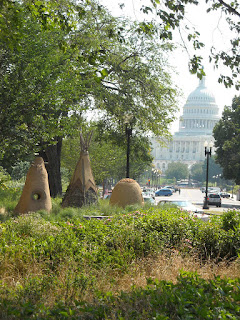Maybe someday I will write short essays about them. But really, they're supposed to be poems, I think.
Here are some ideas that I think would make good poems...
-- The kid across the street from us has grown into a high school senior. When we first moved here, he was a little younger than my son is now, and kind of gawky, definitely a little kid though on the tall side. He went through a rather goofy-looking young-teenager stage, and now before our very eyes, he has become an adult human, tall and poised and more graceful than he used to be, but definitely still a teenager. He drives a car and has a girlfriend and is visiting colleges. He's still a little shy. I look at him and I wonder about my son's next 8 years, wonder what he'll look like and how he'll move and what he'll spend his attention on and what will make him laugh and what will make him angry. I see this kid across the street and I wonder about my son and who he'll become as he becomes an adult.
-- There's an art installation in back of the NMAI called "Always Becoming," by Nora Naranjo-Morse.
 It features structures--smaller scale--that represent traditional native buildings; they're all made from materials that are designed to disintegrate. The art is supposed to dissolve, be impermanent.
It features structures--smaller scale--that represent traditional native buildings; they're all made from materials that are designed to disintegrate. The art is supposed to dissolve, be impermanent.And it's in sight of the Capitol. (Here's a photo that shows you the juxtaposition.)

The contrast is there, sure, but it's almost too easy, and repeats some comparisons that people have been making for centuries. (In my classes we talk about the rhetorics of "civilized" and "savage" that has facilitated the processes of colonization for the past, oh, 500+ years...)
What strikes me as more interesting, and probably a more provocative idea, is that the piece also tells us about endurance, survival, perseverance. Those native living structures mean, for me, that native people are still here, in the place that seems to have nothing to do with them, and in fact was the site of various violent plans to wipe them out or benevolent plans help them to leave behind their "benighted" ways, and all of those plans disastrous. The poem would have to include some play on the word "house"...
-- The sky on the prairie. It makes me feel small, and yet it makes me feel a part of the earth, a part of the sky, connected and observing. It's wondrous, and I'm a witness. Here are some photos...

 ... though of course my camera couldn't capture what it feels like when you've got sky in 360 degrees.
... though of course my camera couldn't capture what it feels like when you've got sky in 360 degrees.-- And the prairie grass. Someone needs to write a poem about the prairie grass...
 ... how it's like the sea, how it whispers on a windy day, how it shows you where the wind is going, how it smells...
... how it's like the sea, how it whispers on a windy day, how it shows you where the wind is going, how it smells... Once upon a time, when I lived in San Francisco, my friend Jane told me about her attempts to write a poem about what it sounded like when she heard a whale surface and breathe. Yes, it's like that: trying to say something that you know is important and deserves the best, most beautiful language possible.
Once upon a time, when I lived in San Francisco, my friend Jane told me about her attempts to write a poem about what it sounded like when she heard a whale surface and breathe. Yes, it's like that: trying to say something that you know is important and deserves the best, most beautiful language possible.I hope you find all the words you need today.
Cheers,
Karen


No comments:
Post a Comment